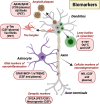Solving neurodegeneration: common mechanisms and strategies for new treatments
- PMID: 35313950
- PMCID: PMC8935795
- DOI: 10.1186/s13024-022-00524-0
Solving neurodegeneration: common mechanisms and strategies for new treatments
Abstract
Across neurodegenerative diseases, common mechanisms may reveal novel therapeutic targets based on neuronal protection, repair, or regeneration, independent of etiology or site of disease pathology. To address these mechanisms and discuss emerging treatments, in April, 2021, Glaucoma Research Foundation, BrightFocus Foundation, and the Melza M. and Frank Theodore Barr Foundation collaborated to bring together key opinion leaders and experts in the field of neurodegenerative disease for a virtual meeting titled "Solving Neurodegeneration". This "think-tank" style meeting focused on uncovering common mechanistic roots of neurodegenerative disease and promising targets for new treatments, catalyzed by the goal of finding new treatments for glaucoma, the world's leading cause of irreversible blindness and the common interest of the three hosting foundations. Glaucoma, which causes vision loss through degeneration of the optic nerve, likely shares early cellular and molecular events with other neurodegenerative diseases of the central nervous system. Here we discuss major areas of mechanistic overlap between neurodegenerative diseases of the central nervous system: neuroinflammation, bioenergetics and metabolism, genetic contributions, and neurovascular interactions. We summarize important discussion points with emphasis on the research areas that are most innovative and promising in the treatment of neurodegeneration yet require further development. The research that is highlighted provides unique opportunities for collaboration that will lead to efforts in preventing neurodegeneration and ultimately vision loss.
Keywords: Alzheimer’s Disease; Biomarker; Cell-replacement; Detection; Genetics; Glaucoma; Glia; Huntington’s Disease; Imaging; Metabolic stress; Model Systems; Neuro-regeneration; Neuro-replacement; Neurodegeneration; Neurovascular coupling; Organoids; Parkinson’s Disease.
© 2022. The Author(s).
Conflict of interest statement
The authors declare that there are no competing interests.
Figures



Similar articles
-
[Aiming for zero blindness].Nippon Ganka Gakkai Zasshi. 2015 Mar;119(3):168-93; discussion 194. Nippon Ganka Gakkai Zasshi. 2015. PMID: 25854109 Review. Japanese.
-
Widespread retina and optic nerve neuroinflammation in enucleated eyes from glaucoma patients.Acta Neuropathol Commun. 2022 Aug 19;10(1):118. doi: 10.1186/s40478-022-01427-3. Acta Neuropathol Commun. 2022. PMID: 35986368 Free PMC article.
-
Targets of Neuroprotection in Glaucoma.J Ocul Pharmacol Ther. 2018 Jan/Feb;34(1-2):85-106. doi: 10.1089/jop.2017.0041. Epub 2017 Aug 18. J Ocul Pharmacol Ther. 2018. PMID: 28820649 Free PMC article. Review.
-
The Role of Neurovascular System in Neurodegenerative Diseases.Mol Neurobiol. 2020 Nov;57(11):4373-4393. doi: 10.1007/s12035-020-02023-z. Epub 2020 Jul 28. Mol Neurobiol. 2020. PMID: 32725516 Review.
-
Common aspects between glaucoma and brain neurodegeneration.Mutat Res Rev Mutat Res. 2020 Oct-Dec;786:108323. doi: 10.1016/j.mrrev.2020.108323. Epub 2020 Aug 13. Mutat Res Rev Mutat Res. 2020. PMID: 33339584 Review.
Cited by
-
Advancing the Frontier: Neuroimaging Techniques in the Early Detection and Management of Neurodegenerative Diseases.Cureus. 2024 May 29;16(5):e61335. doi: 10.7759/cureus.61335. eCollection 2024 May. Cureus. 2024. PMID: 38947709 Free PMC article. Review.
-
cGMP Signaling in the Neurovascular Unit-Implications for Retinal Ganglion Cell Survival in Glaucoma.Biomolecules. 2022 Nov 11;12(11):1671. doi: 10.3390/biom12111671. Biomolecules. 2022. PMID: 36421684 Free PMC article. Review.
-
Phytosome-Encapsulated 6-Gingerol- and 6-Shogaol-Enriched Extracts from Zingiber officinale Roscoe Protect Against Oxidative Stress-Induced Neurotoxicity.Molecules. 2024 Dec 22;29(24):6046. doi: 10.3390/molecules29246046. Molecules. 2024. PMID: 39770133 Free PMC article.
-
NMR Metabolomic Profiling of Differentiated SH-SY5Y Neuronal Cells: Amyloid-β Toxicity and Protective Effects of Galantamine and Lycorine.Cells. 2025 Apr 1;14(7):525. doi: 10.3390/cells14070525. Cells. 2025. PMID: 40214479 Free PMC article.
-
Redox modulatory role of DJ-1 in Parkinson's disease.Biogerontology. 2025 Mar 30;26(2):81. doi: 10.1007/s10522-025-10227-w. Biogerontology. 2025. PMID: 40159591 Review.
References
-
- (WHO) WHO. Globa action plan on the public health response to dementia 2017–2025. 2017.
-
- Leng F, Edison P. Neuroinflammation and microglial activation in Alzheimer disease: where do we go from here? Nat Rev Neurol. 2021;17:157–72. - PubMed
-
- McKhann GM, Knopman DS, Chertkow H, Hyman BT, Jack CR, Jr, Kawas CH, Klunk WE, Koroshetz WJ, Manly JJ, Mayeux R, Mohs RC, Morris JC, Rossor MN, Scheltens P, Carrillo MC, Thies B, Weintraub S, Phelps CH. The diagnosis of dementia due to Alzheimer’s disease: recommendations from the National Institute on Aging-Alzheimer’s Association workgroups on diagnostic guidelines for Alzheimer’s disease. Alzheimers Dement. 2011;7:263–9. - PMC - PubMed
-
- Dujardin S, Commins C, Lathuiliere A, Beerepoot P, Fernandes AR, Kamath TV, De Los Santos MB, Klickstein N, Corjuc DL, Corjuc BT, Dooley PM, Viode A, Oakley DH, Moore BD, Mullin K, Jean-Gilles D, Clark R, Atchison K, Moore R, Chibnik LB, Tanzi RE, Frosch MP, Serrano-Pozo A, Elwood F, Steen JA. Kennedy ME and Hyman BT. Tau molecular diversity contributes to clinical heterogeneity in Alzheimer’s disease. Nat Med. 2020;26:1256–63. - PMC - PubMed
Publication types
MeSH terms
Grants and funding
LinkOut - more resources
Full Text Sources
Medical
Miscellaneous

